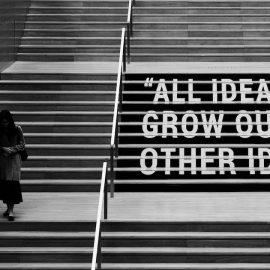

This article is an excerpt from the Shortform book guide to "The Buddha and the Badass" by Vishen Lakhiani. Shortform has the world's best summaries and analyses of books you should be reading.
Like this article? Sign up for a free trial here.
Why should you have bold goals for your company? How do you set business goals?
In The Buddha and the Badass, Vishen Lakhiani says that to project a company’s success, you must have innovative goals. More specifically, he says these goals should be big and bold, not modest.
Read more to learn how to set business goals and set high standards.
Define Bold, Forward-Thinking Goals
To lead a disruptive company, you must develop big, bold goals for it, insists Lakhiani. Unfortunately, most people and leaders are conditioned to aspire to modest goals. But to accomplish something great, you must learn how to set business goals that are audacious, and constantly update them to be even more audacious. If you don’t, your company will languish in mediocrity.
(Shortform note: Some feel that mediocrity isn’t such a bad thing. Being content to perform at an average level frees you from the uncomfortable pressure to always be the best. Being average also means you get to enjoy life’s pleasures because you’re not always straining to become better. You enjoy better mental health because you don’t always see yourself as falling short of big goals.)
Ironically, the bolder your goals are, Lakhiani argues, the easier they are to achieve. This is because when your goals are inspiring and audacious, people with the right skills and enthusiasm will be excited by your cause and want to join it. To have such big, bold goals, Lakhiani warns that you must not be too rational. Otherwise, you’ll start hedging and reducing the scope of your goal to something more manageable.
(Shortform note: While pursuing audacious goals may seem risky, in Principles: Life and Work, Ray Dalio seeks to assuage your fears about going after lofty goals. He writes that when you set a lofty goal and start pursuing it, new avenues and actions will become clear to you, but you’ll only see those avenues and actions if you set the goal in the first place. This argument may appeal to the more rational goal-setters who don’t want to throw themselves into the pursuit of a highly ambitious and uncertain goal.)
Lakhiani provides two tips on attaining goals:
Tip 1: Always speak of your project 10 years down the road to indicate the goal you believe it will achieve in 10 years. Express this goal as if it were already a reality—doing this makes it more likely to happen.
(Shortform note: If you’re not sure of where you want to be in 10 years, consider asking first how much money you want your company to be making at that time. Once you know this, you can think of other, related goals. And others agree you should talk about them as if you know you’ll meet them: Doing this forces you to become more self-aware and thus more specific about how you’ll achieve your goal.)
Tip 2: Don’t be afraid to fail at achieving your goal. If you’re afraid of failing, you won’t think expansively enough to create a bold vision. Lahkiani specifically recommends that 50% of your goals should have a 50% chance of failing. Within your company, you should also strive to set goals that succeed only 60 to 80% of the time. If you have a success rate higher than that, it means your goals aren’t big enough.
(Shortform note: A different take on this advice is to set goals that are 10 times bigger than what you initially think is feasible. Grant Cardone proposes this goal-setting method, but, unlike Lakhiani, doesn’t account for the possibility of failure. He believes that if you set huge goals and invest great effort into accomplishing them, you will. Perhaps a compromise between the two takes would be to set 10x bigger goals and assume that 50% of them have a 50% chance of failing.)

———End of Preview———
Like what you just read? Read the rest of the world's best book summary and analysis of Vishen Lakhiani's "The Buddha and the Badass" at Shortform.
Here's what you'll find in our full The Buddha and the Badass summary:
- Why you don't need to work long, grueling hours to be successful
- How to transform your workplace from mundane to fun
- How to merge spiritual enlightenment with disruption





